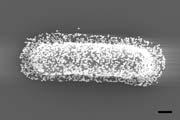 Bacteria were covered with tiny gold particles to turn them into humidity sensors.© Angewandte Chemie/Wiley
Bacteria were covered with tiny gold particles to turn them into humidity sensors.© Angewandte Chemie/WileyLiving bacteria have been incorporated into an electronic circuit to produce a sensitive humidity gauge.
The device unites microbe and machine, taking advantage of the properties of both to make for a supersensitive sensor.
"As far as we know, this is the first report of using microorganisms to make an electronic device," says Ravi Saraf, a chemist from the University of Nebraska, Lincoln, who developed the 'cellborg' with his student Vikas Berry.
"This is essentially a first step towards a biological computer, and would have many applications," says Steve Ripp, a biotechnologist at the University of Tennessee, Knoxville. Ripp was part of a team that developed a sensor that relied on glowing bacteria to detect chemicals. But in their system, the electronic circuits were simply reacting to the bugs, and they weren't hooked up to each other, he notes. Saraf's humidity sensor melds the two together.
Ripp says that interest in these cellborg circuits is growing fast. "If you detect a chemical with a biological device, you not only sense its presence but also its effect on a living system," he says.
Swell sensors
Saraf and Berry made their device from a standard silicon chip inlaid with gold electrodes. First they added a coating of Bacillus cereus bacteria, which clustered together to form bridges between the electrodes. Then they washed the chip with a solution of gold particles, each of which measured about 30 nanometres across and was covered with peptides to help it stick to the bacteria.
The resulting layer of gold nanoparticles bristling from each bacterium carries electrical currents through the device. A rise in moisture levels causes the bacteria to swell slightly, which increases the distance between neighbouring nanoparticles by up to 0.2 nanometres. This tiny separation makes it harder for electrons to hop from one particle to the next, which reduces the current flowing across the chip.
This makes the device much more sensitive that conventional moisture sensors when measuring low humidity, says Saraf. A change from 20% to 0% humidity increased the current flowing through the device by 40 times, whereas the current in a solely electronic device decreases by just ten times.
This could make it particularly useful in situations where small changes in a relatively dry atmosphere can be important, he says.
Zombie bacteria
Just like the Borg of sci-fi legend, the bacteria must stay alive during their assimilation so that they do not leak any internal fluids and lose their shape. The bacteria can survive for about two days without nutrients, says Saraf.
ADVERTISEMENT
"But once the device is made, the device continues to work even after the bacteria die," he says. After a month the zombie bacteria continued to change shape in response to humidity variation, even from beyond the grave.
Saraf speculates that similar devices could one day be made that take greater advantage of living organisms, perhaps even using bacteria's energy systems to power electrical devices. But that will involve going one step further: using a physiological rather than physical response of a bacteria. "One still needs to demonstrate that an electronic coupling between the biology of the microorganism and a nanodevice is possible," he adds.
